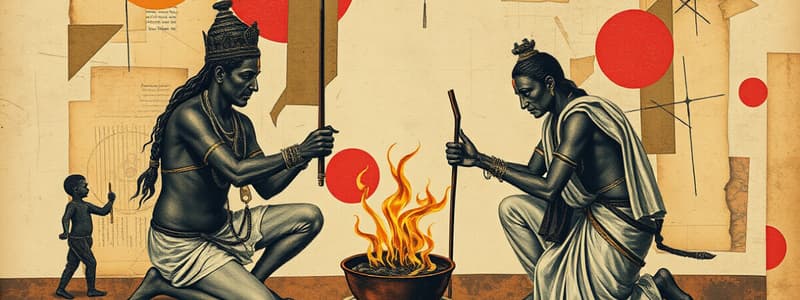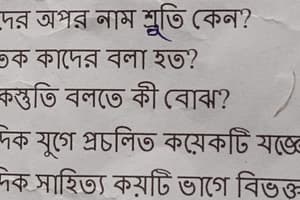Podcast
Questions and Answers
What is the primary purpose of the yajna in Vedic rituals?
What is the primary purpose of the yajna in Vedic rituals?
- To make offerings to gods through fire (correct)
- To celebrate community events
- To commemorate historical figures
- To acquire knowledge and wisdom
Which role among the ritual specialists is primarily responsible for reciting hymns?
Which role among the ritual specialists is primarily responsible for reciting hymns?
- Brahmin
- Udgatri
- Hotri (correct)
- Adhvaryu
What type of offerings are commonly included in Vedic rituals?
What type of offerings are commonly included in Vedic rituals?
- Only fruits and vegetables
- Food, animals, and plants (correct)
- Any form of currency
- Textiles and artifacts
How do Vedic rituals contribute to community life?
How do Vedic rituals contribute to community life?
Which Vedic text is known for containing important mantras for rituals?
Which Vedic text is known for containing important mantras for rituals?
Which Vedic text primarily focuses on philosophical concepts such as Brahman and Atman?
Which Vedic text primarily focuses on philosophical concepts such as Brahman and Atman?
What role do Brahmins primarily play in the Vedic societal structure?
What role do Brahmins primarily play in the Vedic societal structure?
Which of the following is characterized by its focus on rituals and ceremonies in Vedic literature?
Which of the following is characterized by its focus on rituals and ceremonies in Vedic literature?
What is the primary purpose of Yajna in Vedic religious practices?
What is the primary purpose of Yajna in Vedic religious practices?
In which aspect did Vedic texts contribute significantly to early Indian civilization?
In which aspect did Vedic texts contribute significantly to early Indian civilization?
Which concept represents the moral duty or law in Vedic philosophy?
Which concept represents the moral duty or law in Vedic philosophy?
Which group within the Varna system is primarily associated with trade and agriculture?
Which group within the Varna system is primarily associated with trade and agriculture?
The influence of Vedic texts on arts and music is primarily marked by the introduction of which form?
The influence of Vedic texts on arts and music is primarily marked by the introduction of which form?
Flashcards are hidden until you start studying
Study Notes
Religious Practices And Rituals in Vedic Civilization
-
Foundation of Vedic Religion:
- Rooted in the Vedas, the oldest sacred texts of Hinduism.
- Emphasis on rituals, hymns, and sacrifices to divine beings.
-
Hymns and Mantras:
- Use of Sanskrit hymns (Suktas) for invocations and praises.
- Rigveda contains many important mantras for rituals.
-
Yajna (Sacrificial Rituals):
- Central practice; involves offerings to gods through fire.
- Types of yajnas include Agnihotra (daily offering) and Sāttra (long-term rituals).
-
Deities:
- Worship of various deities like Agni (fire), Indra (rain and war), Varuna (cosmic order), and others.
- Rituals aimed at appeasing these deities for prosperity and well-being.
-
Ritual Specialists:
- Priests (Brahmins) play a crucial role in performing rituals and maintaining sacred knowledge.
- Distinction of roles: Hotri (reciter), Adhvaryu (ritual organizer), and Udgatri (chant leader).
-
Sacrificial Offerings:
- Offerings include food, animals, and plants.
- Symbolic meaning tied to themes of creation, sustenance, and the cycle of life.
-
Ritual Objects:
- Use of specific items such as fire altars, vessels, and herbs.
- Each object has particular significance in rituals.
-
Community Participation:
- Rituals often conducted in the presence of the community.
- Collective participation enhances communal bonds and shared beliefs.
-
Seasonal and Life-cycle Rituals:
- Observance of seasonal festivals and life events (birth, marriage, death).
- Important for social cohesion and cultural identity.
-
Cosmology and Philosophy:
- Rituals reflect beliefs about the universe, the cycle of life, and the relationship between humans and the divine.
- Philosophical underpinnings can be seen in later texts like the Upanishads.
-
Transition to Later Practices:
- Evolution of Vedic rituals into later Hindu practices.
- Influence on the development of other religious traditions in the Indian subcontinent.
Foundation of Vedic Religion
- Rooted in the Vedas, which are the oldest sacred texts of Hinduism.
- Focus on rituals, hymns, and sacrifices directed towards divine beings.
Hymns and Mantras
- Sanskrit hymns, known as Suktas, are essential for invocations and praises.
- The Rigveda features many significant mantras used in various rituals.
Yajna (Sacrificial Rituals)
- Central to Vedic practices, involving offerings made to gods through fire.
- Types of yajnas include Agnihotra, a daily offering, and Sāttra, which are long-term rituals.
Deities
- Various deities worshipped include Agni (fire), Indra (rain and war), and Varuna (cosmic order).
- Rituals are intended to appease these deities to achieve prosperity and well-being.
Ritual Specialists
- Priests called Brahmins are key figures in performing rituals and preserving sacred knowledge.
- Specific roles among priests include Hotri (reciter), Adhvaryu (ritual organizer), and Udgatri (chant leader).
Sacrificial Offerings
- Offerings consist of food, animals, and plants, symbolizing themes of creation, sustenance, and life's cycles.
Ritual Objects
- Specific items such as fire altars, vessels, and herbs are used in rituals.
- Each object holds particular significance and purpose within the ritual context.
Community Participation
- Rituals are often conducted in communal settings, promoting collective engagement and reinforcing shared beliefs.
Seasonal and Life-cycle Rituals
- Observances include seasonal festivals and significant life events like birth, marriage, and death.
- Important for social cohesion and maintaining cultural identity within the community.
Cosmology and Philosophy
- Rituals reflect underlying beliefs regarding the universe and the cyclical nature of life and death.
- Philosophical ideas related to these practices are explored in later texts such as the Upanishads.
Transition to Later Practices
- Vedic rituals gradually evolved into later practices in Hinduism.
- The development of these traditions influenced other religious movements across the Indian subcontinent.
Vedic Texts And Literature
- Vedas consist of four main texts: Rigveda, Samaveda, Yajurveda, and Atharvaveda, foundational to Vedic literature.
- Rigveda: The oldest Vedic text, comprised of hymns dedicated to various deities.
- Samaveda: Functions as a musical liturgy featuring melodies and chants for ritual ceremonies.
- Yajurveda: Contains prose mantras specifically for use in sacrificial rituals and ceremonies.
- Atharvaveda: Distinct in its focus on spells, incantations, and domestic rituals rather than purely sacrificial practices.
- Upanishads: Philosophical texts that delve into key concepts of Brahman (universal soul) and Atman (individual soul), vital for understanding Vedic thought.
- Brahmanas: Prose texts providing explanations and instructions regarding rituals and ceremonies.
- Aranyakas: Focus on meditation techniques and the practices of ascetics living in forests.
Societal Structure And Caste System
- Varna System includes four primary social classes:
- Brahmins: Serve as priests and scholars, overseeing religious rituals and imparting knowledge.
- Kshatriyas: Comprise the warrior and ruling class, responsible for the protection of society and governance.
- Vaishyas: Engage in trade, agriculture, and commerce, forming the economic backbone of society.
- Shudras: Perform laborer roles, serving the other three classes in various capacities.
- Jati refers to sub-castes within the varna system, reflecting diverse local customs and specific occupational roles.
- Social Hierarchy is characterized by a rigid structure, allowing minimal social mobility between castes.
Religious Practices And Rituals
- Rituals are central to Vedic religion, performed to please deities and maintain cosmic order known as Rita.
- Yajna: Involves sacrificial flames and offerings made to the deities, emphasizing devotion and reciprocity.
- Homam: A fire ceremony that incorporates chanting and various offerings, playing a significant role in numerous ceremonies.
- Deities: Include nature gods such as Indra (thunder and the sky), Agni (fire), and Varuna (cosmic order), representing different natural forces.
- Ritual Purity: Stresses the significance of cleanliness and adherence to rituals for maintaining spiritual sanctity.
Historical Significance
- Cultural Foundation: Vedic texts laid the groundwork for Hinduism, shaping Indian philosophy, culture, and religious practices.
- Political Organization: Spurred the formation of early kingdoms and political systems influenced by Vedic traditions.
- Transition to Upanishadic Thought: Marked a cultural shift from a focus on rituals to philosophical questioning and meditative practices.
Cultural Contributions To Civilization
- Language: Sanskrit, the language of the Vedas, became the basis for numerous modern Indo-Aryan languages.
- Philosophy: Key concepts such as karma (action), dharma (duty), and moksha (liberation) emerged from Vedic teachings.
- Arts and Music: Influenced various forms of literature, including poetry and drama, enriching cultural expression.
- Science and Mathematics: Contributed early advancements in fields like astronomy, mathematics, and medicine derived from Vedic knowledge.
Studying That Suits You
Use AI to generate personalized quizzes and flashcards to suit your learning preferences.




